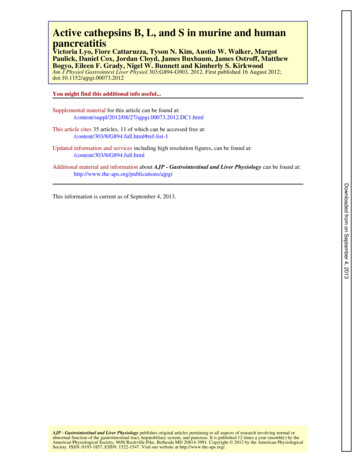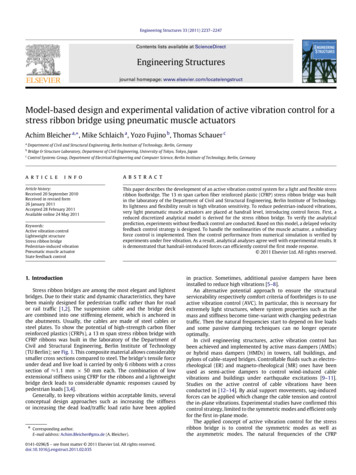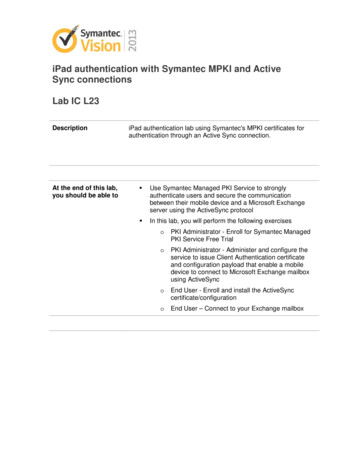
Transcription
Active cathepsins B, L, and S in murine and humanpancreatitisVictoria Lyo, Fiore Cattaruzza, Tyson N. Kim, Austin W. Walker, MargotPaulick, Daniel Cox, Jordan Cloyd, James Buxbaum, James Ostroff, MatthewBogyo, Eileen F. Grady, Nigel W. Bunnett and Kimberly S. KirkwoodAm J Physiol Gastrointest Liver Physiol 303:G894-G903, 2012. First published 16 August 2012;doi:10.1152/ajpgi.00073.2012You might find this additional info useful.Supplemental material for this article can be found htmlThis article cites 35 articles, 11 of which can be accessed free at:/content/303/8/G894.full.html#ref-list-1Updated information and services including high resolution figures, can be found at:/content/303/8/G894.full.htmlAdditional material and information about AJP - Gastrointestinal and Liver Physiology can be found at:http://www.the-aps.org/publications/ajpgiAJP - Gastrointestinal and Liver Physiology publishes original articles pertaining to all aspects of research involving normal orabnormal function of the gastrointestinal tract, hepatobiliary system, and pancreas. It is published 12 times a year (monthly) by theAmerican Physiological Society, 9650 Rockville Pike, Bethesda MD 20814-3991. Copyright 2012 by the American PhysiologicalSociety. ISSN: 0193-1857, ESSN: 1522-1547. Visit our website at http://www.the-aps.org/.Downloaded from on September 4, 2013This information is current as of September 4, 2013.
Am J Physiol Gastrointest Liver Physiol 303: G894–G903, 2012.First published August 16, 2012; doi:10.1152/ajpgi.00073.2012.Active cathepsins B, L, and S in murine and human pancreatitisVictoria Lyo,1 Fiore Cattaruzza,1 Tyson N. Kim,1 Austin W. Walker,1 Margot Paulick,2 Daniel Cox,1Jordan Cloyd,1 James Buxbaum,3 James Ostroff,3 Matthew Bogyo,2 Eileen F. Grady,1 Nigel W. Bunnett,3and Kimberly S. Kirkwood11Department of Surgery, University of California, San Francisco, San Francisco, California; 2Department of Pathology,Stanford University, Stanford, California; 3Department of Gastroenterology, University of California, San Francisco,San Francisco, California; Departments of Pharmacology and Medicine, Monash Institute of Pharmaceutical Sciences,Parkville, Victoria, AustraliaSubmitted 28 February 2012; accepted in final form 18 July 2012experimental acute pancreatitis; pain; cathepsins; activity-basedprobes; near-infrared imagingis critical to the initiationof pancreatitis. Cysteine cathepsins (Cat) control trypsinogenprocessing within acinar cells and contribute to the development of pancreatitis (5, 13, 29, 35). Our understanding of theseevents has been limited by difficulties in isolating and measuring active forms of proteases in tissue. This limitation has, inturn, hindered efforts to delineate the pathways by whichactivated proteases cause pain, which is a major clinical prob-PREMATURE ACTIVATION OF TRYPSINOGENAddress for reprint requests and other correspondence: K. S. Kirkwood,UCSF, 513 Parnassus Ave., Rm. S1268, San Francisco, CA 94143-0660(e-mail: kim.kirkwood@ucsfmedctr.org).G894lem in patients with both acute and chronic forms of pancreatitis.Proteases control inflammation and pain by generating mediators and cleaving protease-activated receptors. Proteases areparticularly important in pancreatitis, an autodigestive diseasein which prematurely activated digestive enzymes, such astrypsin, cause pancreatic injury, inflammation, and pain. Proteases from infiltrating inflammatory cells and the circulationmay also contribute to pancreatitis. However, the identity andcellular source of the proteases that are activated in pancreatitisare unknown, and their causative roles in pancreatic inflammation and pain are incompletely defined.Cysteine cathepsins, of which there are 11 in the humangenome, have diverse pathophysiological functions (5). Bydegrading proteins in acidified organelles, cathepsins regulateprotein turnover, zymogen activation, antigen presentation, andhormone processing. Cathepsins play important roles in cancers, osteoporosis, inflammatory/immune diseases, and allergicdisorders. Cathepsins contribute to pancreatitis by regulatingthe activity of trypsin within acinar cells. Cathepsin B (Cat-B)mediates the premature and inappropriate activation of trypsinogen, an important early event in the pathogenesis of pancreatitissince Cat-B inhibition or deletion attenuates trypsinogen activation and pancreatic inflammation (13, 29, 35). Cathepsin L(Cat-L) can degrade both trypsinogen and trypsin and couldthereby mitigate the harmful effects of Cat-B by reducingtrypsin activity (36). However, Cat-L deletion lessens theseverity of pancreatic inflammation (36), suggesting a morecomplex role for Cat-L, possibly involving induction of apoptosis.In addition to their intracellular roles, certain cathepsins are alsosecreted and can remain fully [cathepsin S (Cat-S)] or partially(Cat-B, Cat-L) active in the extracellular environment, wherethey may have widespread effects (28). Cat-S is secreted byspinal microglia after neuronal injury and is critical for maintenance of neuropathic pain (8, 9).Analysis of nucleic acid or protein expression fails to provide information on dynamic, posttranslational regulation andactivity levels of enzymatic proteins such as proteases. Pancreatic proteases are synthesized as inactive zymogens and,once activated, participate in complex enzymatic cascades andare also subject to tight posttranslational regulation by endogenous inhibitors. Thus, to accurately determine the impact ofproteases, we need to measure functional activity within adiseased tissue. However, conventional activity assays arelimited by lack of selectivity and are unsuited for dynamicdetermination of protease activity in intact organisms. Activitybased probes (ABPs) are small molecule probes that can beused to localize and identify proteases in their active forms0193-1857/12 Copyright 2012 the American Physiological Societyhttp://www.ajpgi.orgDownloaded from on September 4, 2013Lyo V, Cattaruzza F, Kim TN, Walker AW, Paulick M, Cox D,Cloyd J, Buxbaum J, Ostroff J, Bogyo M, Grady EF, Bunnett NW,Kirkwood KS. Active cathepsins B, L, and S in murine and humanpancreatitis. Am J Physiol Gastrointest Liver Physiol 303: G894 –G903,2012. First published August 16, 2012; doi:10.1152/ajpgi.00073.2012.—Cathepsins regulate premature trypsinogen activation within acinarcells, a key initial step in pancreatitis. The identity, origin, andcausative roles of activated cathepsins in pancreatic inflammation andpain are not defined. By using a near infrared-labeled activity-basedprobe (GB123) that covalently modifies active cathepsins, we localized and identified activated cathepsins in mice with cerulein-inducedpancreatitis and in pancreatic juice from patients with chronic pancreatitis. We used inhibitors of activated cathepsins to define theircausative role in pancreatic inflammation and pain. After GB123administration to mice with pancreatitis, reflectance and confocalimaging showed significant accumulation of the probe in inflamedpancreas compared with controls, particularly in acinar cells andmacrophages, and in spinal cord microglia and neurons. Biochemicalanalysis of pancreatic extracts identified them as cathepsins B, L, andS (Cat-B, Cat-L, and Cat-S, respectively). These active cathepsinswere also identified in pancreatic juice from patients with chronicpancreatitis undergoing an endoscopic procedure for the treatment ofpain, indicating cathepsin secretion. The cathepsin inhibitor K11777suppressed cerulein-induced activation of Cat-B, Cat-L, and Cat-S inthe pancreas and ameliorated pancreatic inflammation, nocifensivebehavior, and activation of spinal nociceptive neurons. Thus pancreatitis is associated with an increase in the active forms of the proteasesCat-B, Cat-L, and Cat-S in pancreatic acinar cells and macrophages,and in spinal neurons and microglial cells. Inhibition of cathepsinactivation ameliorated pancreatic inflammation and pain. Activitybased probes permit identification of proteases that are predictivebiomarkers of disease progression and response to therapy and may beuseful noninvasive tools for the detection of pancreatic inflammation.
ACTIVE CATHEPSINS IN PANCREATITISMATERIALS AND METHODSMice. The University of California, San Francisco (UCSF) Institutional Animal Care and Use Committee approved all procedures withmice. C57BL/6 mice (male, female, 20 –25 g) were from CharlesRiver Laboratories (Hollister, CA). Mice were maintained undertemperature- (22 4 C) and light- (12-h light-dark cycle) controlledconditions with free access to food and water. Mice were killed withsodium pentobarbital (200 mg/kg ip).Materials. GB123, a nonquenched ABP with an acyloxymethylketone warhead and a Cy5.5 tag, has been described (Fig. 1A) (3, 4).GB123 interacts with cysteine cathepsins and is serum stable, cellpermeant, and suitable for administration to animals. Human Cat-B,Cat-L, and Cat-S were from EMD Biosciences (La Jolla, CA).K11777 (17) (Fig. 1B) was a gift from Dr. J. McKerrow (UCSF), andHALT Complete Protease Inhibitor Cocktail was from Pierce (Rockford, IL). Sources of primary antibodies are shown in Table 1.Biotinylated anti-rabbit IgG was from Vector Laboratories (Burlingame, CA). Anti-IgG conjugated to Rhodamine RedX was fromJackson Immunoresearch (West Grove, PA). Other reagents werefrom Sigma-Aldrich (St. Louis, MO).Cerulein-induced pancreatitis and administration of ABP. Micereceived hourly injections of cerulein (50 g/kg ip) or vehicle (0.9%NaCl) for 12 h (6). A subset of mice was treated with K11777 (50mg/kg ip) or vehicle (30% DMSO H2O) twice daily starting 1 dayprior to induction of pancreatitis and continuing throughout theexperiment. Mice either were killed immediately after the final dose ofcerulein or received GB123 (25 nmol/mouse, 66% DMSO PBS, 100 l iv) 30 min after the final cerulein dose and were killed 24 h later.Some mice received GB123 intrathecally (1.25 nmol/mouse, 66%DMSO PBS, 10 l) after the tenth cerulein dose, and the spinal cordwas collected after the final dose of cerulein. Mice were transcardiallyFig. 1. GB123 interacts with purified cathepsins. A: GB123 with a Cy5.5fluorophore and an acyloxymethylketone (AOMK) warhead that binds to theactive site of cysteine cathepsins. MW, molecular weight. B: K11777, anirreversible cathepsin inhibitor. C: human cathepsin B (Cat-B), cathepsin L(Cat-L), or cathepsin S (Cat-S) (25 ng) (B, L, and S, respectively) were boundto GB123. Probe-bound proteases were detected by SDS-PAGE and in-gelfluorescence. K11777 (50 –100 nM) abolished GB123 binding.perfused with 30 ml 0.1 M PBS pH 7.4 and tissues were collected foranalysis.Ex vivo reflectance imaging of the pancreas. Excised pancreatawere analyzed for GB123 by reflectance imaging (Xenogen IVIS100,Caliper Life Sciences, Hopkinton, MA) using the Cy5.5 filter. Signalsfrom cerulein-treated pancreata were normalized to signals in controlpancreata in each experimental group and are expressed as foldincrease over control.Two-photon imaging of pancreas and spinal cord. Pancreas andspinal cord (T8 –T9) were fixed in 4% paraformaldehyde 0.1 M PBSpH 7.4 (1 h, room temperature), and optically cleared in a gradient of5– 60% sucrose PBS. Flat-mounted tissues in 60% sucrose wereimaged by use of a locally designed two-photon laser scanningmicroscope. Low-energy 100-fs 80-MHz pulses were generated byuse of a titanium-sapphire laser oscillator (Mai Tai, Newport SpectraPhysics, Irvine, CA) tuned to 1,020 nm for excitation of Cy5.5.MPScan imaging software was used to control the microscope andcollect images (24). Stacks of images (400 m deep at 1- m axialspacing) were collected and analyzed with Image J (NIH). Identicalcollection parameters were used for pancreatitis and control tissues.Immunofluorescence confocal imaging of pancreas and spinalcord. Pancreas and spinal cord (T8 –T9) were fixed in paraformaldehyde (4 h, room temperature), cryoprotected (30% sucrose PBS,overnight, 4 C), and frozen sections (10 –14 m) were prepared.Sections were incubated with primary antibodies (Table 1) in 0.1 MPBS pH 7.4, 10% normal horse serum, and 0.1% Triton X-100.Sections were incubated with fluorescent secondary antibodies (1:200,1 h, room temperature). Sections were observed by using a ZeissLSM510 Meta and Axiovert microscope with Plan Neo-Fluar 40(NA 0.8) and Plan Neo-Fluar 63 (NA 1.4) objectives. Images(1,024 1,024 pixels) were acquired at 0.44- to 0.74- m intervals byusing a pinhole of 1.04 –1.86 Airy units. Identical collection parameters were used for pancreatitis and control tissues.Human pancreatic juice. Human pancreatic juice was obtainedfrom patients with chronic pancreatitis undergoing endoscopic retrograde cholangiopancreatography. The protocol was approved by theUCSF Human Subjects Committee, and samples were collected withAJP-Gastrointest Liver Physiol doi:10.1152/ajpgi.00073.2012 www.ajpgi.orgDownloaded from on September 4, 2013(10). ABPs comprise a warhead group, usually derived from aprotease inhibitor, that covalently binds to the active site, plusa peptide linker, and a near-infrared tag for detection. Whenadministered to experimental animals, ABPs can be used tomonitor protease activity in diseased organs in vivo, and evenin situ. Probe-bound proteases can be subsequently localized atthe cellular level, and identified by proteomic analysis. ABPsbased on an acyloxymethylketone warhead have been used tolocalize and identify active cathepsins in tumors (3, 4) but havenot been used to study cathepsins in inflammatory diseasessuch as pancreatitis.We used ABPs with an acyloxymethylketone warhead and anear-infrared tag to identify and localize active forms ofcathepsins in the pancreas and spinal cord during pancreatitis.By reflectance imaging and two-photon confocal microscopyof intact organs, we detected active cathepsins throughout thepancreas and in the thoracic spinal cord from mice with acutepancreatitis. Active cathepsins were localized to acinar cellsand infiltrating macrophages of the pancreas, and to spinalmicroglial cells and neurons. Proteomic analysis revealed amarked increase in active forms of Cat-B, Cat-L, and Cat-S inthe inflamed mouse pancreas and in pancreatic juice frompatients with chronic pancreatitis. Cathepsin inhibition ameliorated pancreatic inflammation and pain in mice. We identifiedincreased active forms of Cat-B and Cat-L in acinar celllysosomes and increased active Cat-S in macrophages of thepancreas and spinal cord. Our data support the notion thatactive cathepsins are essential for pancreatic inflammation andpain and secreted cathepsins could contribute to human pancreatitis pain. Moreover, ABPs can be used to identify biomarkers of disease progression and response to therapy.G895
G896ACTIVE CATHEPSINS IN PANCREATITISTable 1. Primary antibodiesAntibodySpeciesConditionsSourceMouse Cat-B (AF965)Mouse Cat-L (AF1515)Human Cat-S (AF1183)Cat-B (S-12 sc-6493)Cat-L (D-20 sc-6501)Cat-S (M-19 sc-6505)F4/80LAMP1NeuNGFAP (AB5541)Ox42 (M1/70) kenRatMouseRabbitIP: 1.0 g, overnight, 4 CIP: 1.0 g, overnight, 4 CIP: 1.0 g, overnight, 4 CIF: 1:300, overnight, 4 CIF: 1:300, overnight, 4 CIF: 1:300, overnight, 4 CIF: 1:200, overnight, 4 CIF: 1:300, overnight, 4 CIF: 1:500, overnight, 4 CIF: 1:250, overnight, 4 CIF: 1:200, overnight, 4 CWB: 1:10,000, overnight, 4 CIH: 1:20,000, overnight, 4 CR&D Systems (Minneapolis, MN)R&D Systems (Minneapolis, MN)R&D Systems (Minneapolis, MN)Santa Cruz Biotechnology (Santa Cruz, CA)Santa Cruz Biotechnology (Santa Cruz, CA)Santa Cruz Biotechnology (Santa Cruz, CA)BMA Biomedicals (Augst, Switzerland)ABR Affinity Bioreagents (Golden, CO)Millipore (Billerica, MA)Millipore (Billerica, MA)BD Pharmigen (San Diego, CA)Sigma-Aldrich (St. Louis, MO)Chemicon (Temecula, CA)IF, immunofluorescence; IH, immunohistochemistry; WB, Western blotting; IP, immunoprecipitation.Fig. 2. Reflectance imaging of activated pancreatic cathepsins. Pancreas fromGB123-treated mice show increased GB123 signal in cerulein-treated mice,determined by reflectance imaging [red box denotes region of interest fromwhich signal was quantified; scale denotes photons per second per squarecentimeter per steradian (p·s 1·cm 2·sr 1)]. Fluorescence signal in ceruleintreated pancreata are expressed as fold control. Control, n 6; cerulein, n 8. **P 0.01.Immunoprecipitation. Pancreas homogenates from GB123-treatedmice (200 g protein) or GB123-treated human pancreatic juice (50 g protein) were incubated with antibodies to Cat-B, Cat-L, or Cat-S[1–2 g, 0.75 ml of RIPA buffer (50 mM Tris·HCl pH 7.4, 150 mMNaCl, 5 mM EDTA, 0.5% deoxycholate, 0.1% SDS), 1 h, roomtemperature]. Protein A/G Plus Agarose beads (Santa Cruz Biotechnology) were added and incubated overnight at 4 C. Beads werewashed with RIPA and analyzed by SDS-PAGE and in-gel fluorescence.Assessment of pancreatitis. Pancreatitis was assessed by measurement of serum amylase activity, wet pancreatic weight normalized tobody weight, and histological examination (6). For histology, sectionsstained with hematoxylin and eosin were evaluated by an investigatorunaware of the experimental groups and scored on a scale from 0 –5for 1) macrolobular edema, 2) microlobular edema, 3) zymogendegranulation, 4) polymorphonuclear leukocyte infiltration, 5) polymorphonuclear leukocytes in peripancreatic fat, 6) vacuoles in acinarFig. 3. Identification of activated pancreatic Cat-B, Cat-L, and Cat-S. A: pancreas homogenates from GB123-treated mice were analyzed by SDS-PAGEand in-gel fluorescence. GB123-bound proteases corresponding in mass toCat-B, Cat-L, and Cat-S were activated after cerulein. Nonspecific proteins of 10 kDa and 90 kDa also bound to GB123, as described (4). B: immunoprecipitation confirmed identify of Cat-B, Cat-L, and Cat-S. C: quantificationrevealed activation of Cat-B, Cat-L, and Cat-S. Control, n 4; cerulein, n 6. *P 0.05, **P 0.01.AJP-Gastrointest Liver Physiol doi:10.1152/ajpgi.00073.2012 www.ajpgi.orgDownloaded from on September 4, 2013informed patient consent. Aliquots were either immediately frozen inliquid nitrogen or pretreated with K11777 (50 nM) or HALT proteaseinhibitor cocktail (1 ) with 5 mM EDTA before freezing.In vitro reactions with ABPs. Human Cat-B, Cat-L, or Cat-S (25ng) was incubated with K11777 (50 or 100 nM) or vehicle (30%DMSO in H2O) for 30 min at room temperature in 400 mM sodiumacetate pH 5.5, 4 mM EDTA, 8 mM DTT (Cat-B, Cat-L) or 20 mMpotassium phosphate pH 7.4, 5 mM EDTA, 5 mM DTT (Cat-S).GB123 was added (1 M final) and allowed to react for 1 h. Humanpancreatic juice (20 g protein) was similarly incubated with K11777(50 nM), HALT (1 ) or vehicle and GB123. Reactions were stoppedby boiling (5 min) in 4 sample buffer (200 mM Tris pH 6.8, 12%SDS, 40% glycerol, 0.4 mg/ml bromophenol blue, 5% -mercaptoethanol). Samples were analyzed by SDS-PAGE (15% acrylamide),and GB123-bound proteins were detected by in-gel fluorescence(700 nm; Odyssey Infrared Imaging System, LiCOR Bioscience,Lincoln, NE).SDS-PAGE and Western blotting. Pancreata from GB123-treatedmice were homogenized in 5 mM MOPS pH 6.5, 250 mM sucrose.Homogenates (60 g protein) were analyzed by SDS-PAGE andin-gel fluorescence. Proteins were transferred to polyvinylidene difluoride membranes, which were analyzed by Western blotting for -actin. GB123 signals were normalized to -actin signals, andsignals from cerulein-treated samples were expressed as fold control.
G897ACTIVE CATHEPSINS IN PANCREATITIScells, and 7) necrosis. Scores were tabulated and the mean value foreach experimental group defined the histological severity score.Assessment of pancreatic pain. To assess activation of nociceptive spinal neurons, c-Fos-immunoreactivity (IR) was localized insections (45 m) of spinal cord (T6 –T12) by immunohistochemistry (6). Slides were examined by an invest
Active cathepsins B, L, and S in murine and human pancreatitis Victoria Lyo,1 Fiore Cattaruzza,1 Tyson N. Kim,1 Austin W. Walker,1 Margot Paulick,2 Daniel Cox,1 Jordan Cloyd,1 James Buxbaum,3 James Ostroff,3 Matthew Bogyo,2 Eileen F. Grady,1 Nigel W. Bunnett,3 and Kimberly S. Kirkwood1 1Department of Surgery, University of Califor











